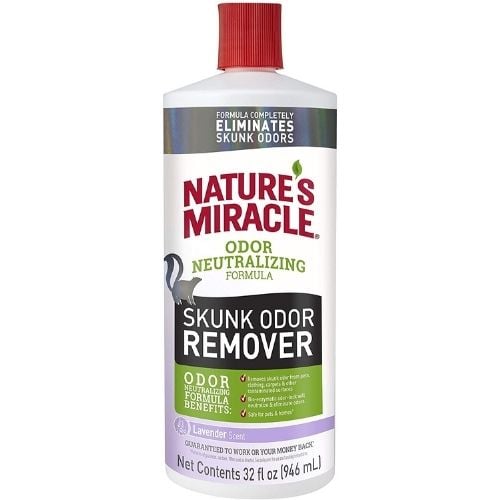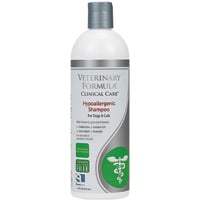 We love exploring the outdoors with our pets. There are so many amazing adventures, sights, and wonderful smells. But there are times when those smells may not be so wonderful. This is especially the case when you and your pet have an encounter with a skunk.
We love exploring the outdoors with our pets. There are so many amazing adventures, sights, and wonderful smells. But there are times when those smells may not be so wonderful. This is especially the case when you and your pet have an encounter with a skunk.
Fun fact: Skunks are a natural form of insect, pest, and rodent control in gardens and around farms. Living in harmony with them is ideal.
Skunks are everywhere, even in the inner city, and often our pets get curious about them. I mean, they are cute! But this curiosity usually ends in a face full of yucky spray from the skunk.
Skip to section:
What to Do If Your Pet Gets Skunked
Step 1: DON'T panic!
I know that is so much easier said than done. There are several reasons to stay calm, though.
- You can't risk coming into contact with an animal that can carry rabies. So, assess where the skunk is and work on removing your pet from the situation.
- You need to calmly get your pet away from the skunk. If you are, well, hysterical, your pet will not respond as you want them to.
- When we're in a panic, we can act impulsively. DO NOT grab your pet and run in your house or jump in your car, that smell can last for years if it has not been completely removed from your pet's skin and fur prior.
Step 2: Gain control of your pet
If your pet was skunked in the face, they could be in a great deal of pain and discomfort. This can make getting a hold of them tricky. If your dog is off-leash, grabbing a slip lead and gently looping it over their head may be much easier than trying to grab a hold of their collar and clip on a leash.
If you are lucky, the encounter with the skunk has happened near your home. This allows you to act quickly in evaluating your pet and then start de-odorizing them. Remember, try to do all deodorizing outside.
If you're not at home, perhaps out hiking or walking when your pet gets sprayed and need to put your pet in the car, try letting them run through some grass and weeds or wipe them down with a rag to perhaps lessen some of the oils on the fur and skin. When putting them into the car, prevent them from coming into contact with the seats and floor carpet, as it will contaminate your car with a smell that can be virtually impossible to remove. You can wrap them in a towel, rag, clothes (hopefully nothing you want to keep), or even newspaper before placing them securely in your car.
Step 3: Evaluate your pet
The first thing you must do is evaluate your pet's face. They have most likely been sprayed there, and the irritant has gotten into their eyes, mouth, and nose. You must flush any of the skunk spray off, especially at their eyes. You can use cool water or an eye saline solution flush (preservative-free human solution is fine) for the eyes and then apply artificial tears to the eyes. Use a towel or rag to gently wipe the rest of the face.
Restraining your pet while trying to evaluate them can be difficult — being skunked can be disorienting and scary, especially if they can't see if they've been sprayed in the face. If possible, get someone to help you. You can wrap your dog or cat in a towel, much like swaddling, to try and calm them (and protect you from getting scratched). Speak to them in a calm, low-pitched voice, to reassure them and encourage them to relax. Depending on their level of stress, offering a food distraction might work to keep them more still while you look them over.
Once you have taken care of your pet's face, it is time to deal with the rest of their body and get the smell out.
How to Deodorize Your Smelly Pet
If you are one of the fortunate pet owners to have Nature’s Miracle Skunk Odor Remover or another similar brand on hand, you have a pretty quick fix to your smelly situation.

Be sure to wear gloves when handling your pet. And if the smell is bothering you, wearing a mask can help.
Be sure to wipe off as much oil before bathing as possible. As mentioned below in the skunk facts section, skunk spray is oil and it does not mix well with water. When it becomes wet, the smell becomes stronger. Read the label directions carefully before applying any shampoo. Remember, these shampoos can be very irritating to your pet’s eyes. Be sure to apply eye lube before bathing and use caution not to get any shampoo or face cleanser in their eyes.
Ideally, you should consult your veterinarian before using any of skunk spray removal products. Not all "pet-approved" products are truly pet-approved. Some animals can have health issues, such as skin infections, allergies to the ingredients, etc.
What if You Don't Have a De-skunking Shampoo?
Fret not because there are some DIY solutions you can mix up! While you are making your DIY deodorizer mixture, find a way to safely confine your pet outside.
Does Tomato Juice Work for Skunk Spray?
Tomato juice masks the skunk smell but doesn't even come close to eliminating it. Even worse, it only masks the smell for you. This is due to something called "olfactory fatigue," which means the scent of tomato juice will help trick your nose into thinking the smell is gone. Other people, especially if the smell gets into your home or car ... not so much.
DIY Deskunking Mixture #1
This first mixture is made up of ingredients that most people have at home or can very easily get from the store or neighbor.
Step 1: Make the mixture. Mix together:
- 1 quart 3% hydrogen peroxide
- ¼ cup of baking soda
- 1 teaspoon of liquid dishwashing soap
Step 2: Apply the mixture immediately to your pet.
Safety Cautions for this mixture:
- DO NOT get any of this solution in your pet’s eyes since it is an irritant.
- If your pet licks or consumes the solution, they can foam at the mouth and may vomit.
- This mixture can explode if left in a bottle. Therefore, do not store this mixture after use.
Step 3: While wearing gloves, gently massage the mixture into the fur and on the skin.
Step 4: Leave the mixture on your pet for 20 minutes before rinsing. Longer than this can risk bleaching the fur, especially on black or dark brown fur.
Step 5: Rinse your pet’s fur and skin well. Then bathe them in a pet shampoo. Ideally, use a hypoallergenic shampoo. Be sure to rinse well again. You may want to use some conditioner, especially if you need to watch your pet several times.
You may need to repeat the above process two or three more times.
Step 6: Dry your pet well and let them rest. A treat would be a nice reward.
Step 7: Dispose of your gloves and clean your clothes.
For the next few months, you may notice some skunky odor following the dreaded incident every time your pet gets wet. Typically this isn’t the case with commercially made de-skunking shampoos.
DIY Deskunking Mixture #2
This second DIY mixture uses apple cider vinegar diluted in water (2 parts water to 1 part vinegar). Follow the same steps as listed above to bathe your pet.
DIY Deskunking Option #3
Another option is using a feminine hygiene product – but just for dogs, not cats. Basically, you will be mixing Massengill douche with water. If your pet has sensitive skin or allergies, use caution in using this product, as it does have a fragrance.
- Small to medium dogs – 2 ounces of Massengill with 1 gallon of water.
- Large dogs – 4 ounces of Massengill with a gallon of water.
- Thoroughly soak your pet with the mixture
- Rinse coat thoroughly after letting the mixture sit for 15 minutes
- Wash well in pet shampoo and rinse thoroughly
NOTE: Before use, consult with your pet’s veterinarian to see if any of these options are right for your pet.
How to Get the Odor Out of Your Clothes or Car
Your beloved pet ended up sharing their new ”perfume” with your clothes. That smell is stubborn and oh so hard to get rid of. You may be wondering what options you have.
- Throw away your clothes! OR
- Wash your clothes in hot water and a powerful laundry detergent mixed with baking soda (½ cup) — repeat twice.
- Be sure that you read the care instructions on the clothing label before trying this.
- Let the clothes air dry. Drying them in the heat of a dryer may "seal" the skunk smell deeper into the fabric.
While we haven't tried the exact techniques listed on this site, you may want to check them out to get rid of the smell in your car, home, and clothing.
Car tip: If you end up having to have your smelly friend in the car, you can later buy an ozone generator to help remove the skunk smell.They have been found to help with leftover odors.
Making an emergency "skunk kit" for when you travel with your dog is a good idea.
Deskunking Emergency Kit – store in a bucket or plastic box:
- Eye Wash
- Eye Lube
- Wash Cloths
- Towels
- Water
- Skunk Off Shampoo or 1 quart Hydrogen peroxide, ¼ cup baking soda, and 1 teaspoon of dish soap (Dawn®)
- Pet Shampoo
Important Skunk & Pets Facts
The first thing we often do is panic when we see a skunk, but the first thing our pet may do is chase or attack them. As a pet owner, there are some important things you need to know about skunks and their spray.
Skunks are Carriers of Rabies
Annually, in the United States, skunks account for about 20% of the animals that test positive for rabies. This percentage is even higher in Canada (40%). So it is very important to have your pet’s rabies vaccine current. The vaccination requirements for rabies vary from state to state and country to country.
Any time your pet comes into contact with a wild animal known to carry rabies, contact the local animal control immediately and your veterinarian within 24 hours. All animals with current rabies vaccine should be re-vaccinated following potential and known exposure, such as if they've been bitten or scraped by a skunk or other rabies-carrying wildlife like raccoons.
Since there is a zoonotic concern — transfer of disease from an animal to a human — it is important to be aware of the fact that skunks are also known carriers of Leptospirosis.
The Reason Skunks Spray
Typically, skunks spray because they feel scared or threatened. They are gentle by nature, and taking offense is very uncommon. The spray is simply a defense weapon used when hissing, stomping feet, and tail arching doesn’t discourage would-be curious or attacking animals or people. The spray can go a distance of several feet. There have been sources that say skunks can spray up to 15 feet. To make matters worse, they have enough spray to repeat the process 5 times before they need to "recharge"! Therefore, use continued caution at all times.
What's Skunk Spray Made Of?
We all know oil and water don’t mix. So, having an understanding of the chemical composition of skunk spray in order to neutralize it effectively is helpful.
- Unfortunately, skunk spray is a yellow oil that tends to adhere or stick to most things it comes into contact with.
- Being an oil, it does not mix well with water.
- When it becomes wet, the skunk smell is enhanced or becomes stronger.
- There are up to seven different compounds in skunk spray that can easily become a gas when the spray is released into the air or exposed to water. This is the reason the smell is so awful. Thiols or thioacetates, the compounds found in skunk spray, bind quickly and strongly to skin proteins.
How Skunk Spray Can Affect Your Dog or Cat
As if the smell isn't bad enough, there are some other things to be concerned about. Most often, your pet will be sprayed in the face. If the spray gets into their mouth, it can cause nausea, drooling, and vomiting.
If your pet happens to swallow this horrible spray, the irritating compounds in the spray, can (in rare cases) cause damage to the red blood cells resulting in anemia.
The spray is as irritating to the eyes as pepper spray. Your pet may experience redness, swelling around the eyes, and temporary blindness. If your pet excessively rubs at their eyes, they risk injuring the cornea. That is why wiping the face and rinsing your pet's eyes is critical.
Is It Possible to Avoid Future Skunking Events?
Hopefully, your pets will never have a run-in with a skunk. But to help decrease the chances, here are some tips to follow.
-
Since skunks are normally more active at dusk and dawn, turn outdoor lights on so your yard is well-lit. Additionally, walking your dog on a leash is also highly recommended.
-
Placing solar lights throughout your entire yard will make the area less inviting to skunks.
-
Having automatic water sprinklers come on throughout the night makes for an unwelcoming environment for skunks.
-
Do not leave any food or treats outside.
-
Be sure to cover all trash cans securely.
-
Block off any access to sheds or areas under porches and decks.
-
Remove any debris, such as piles of brush or wood that may make a nice new home for a skunk.
-
If you frequently walk or hike with your dog off-leash in skunk country, consider training skunk avoidance. This can be done the same way as snake avoidance, using positive reinforcement techniques.
-
Teach your dog an emergency recall behavior. While your dog may come when called for the most part with their regular cue, having an emergency recall cue can be especially beneficial for high distraction and dangerous moments, such as when your dog takes interest in a skunk.




